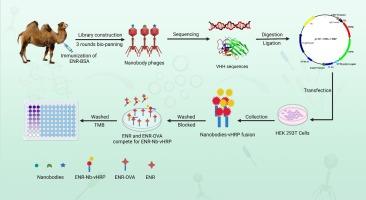开发基于纳米抗体-辣根过氧化物酶融合的竞争性酶联免疫吸附试验,快速灵敏地检测动物源食品中的恩诺沙星残留量
IF 4.3
2区 化学
Q1 SPECTROSCOPY
Spectrochimica Acta Part A: Molecular and Biomolecular Spectroscopy
Pub Date : 2024-10-21
DOI:10.1016/j.saa.2024.125309
引用次数: 0
摘要
能否可靠地检测动物源食品中的恩诺沙星对健康具有重要影响。在本研究中,生成了一种特异于恩诺沙星的纳米抗体-辣根过氧化物酶融合物,从而实现了一种灵敏、快速的竞争性酶联免疫吸附试验,适用于检测牛奶和动物组织样本中的恩诺沙星。通过戊二醛法生成的恩诺沙星单体最初被用来免疫成年双峰驼,作为构建噬菌体库的一种手段。然后,通过三轮生物筛选筛选出恩诺沙星特异性纳米抗体,并表达这些纳米抗体的 HRP 融合版本。最后,利用这些纳米抗体开发出一种灵敏的 cELISA 检测方法,用于检测牛奶和动物组织中的恩诺沙星,其 IC50 值为 37.41 ng/mL,线性检测范围(IC20-IC80)为 10.89 至 244.34 ng/mL。该 cELISA 的检测限为 6.48 纳克/毫升,与环丙沙星的交叉反应率为 4.66%,回收率为 84.99% 至 107.72%,RSD 低于 10.70%。本文章由计算机程序翻译,如有差异,请以英文原文为准。

Development of a nanobody-horseradish peroxidase fusion-based competitive ELISA to rapidly and sensitively detect Enrofloxacin residues in animal-derived foods
The ability to reliably detect enrofloxacin in animal-derived food products has important health implications. In the present study, a nanobody-horseradish peroxidase fusion specific for ENR was generated to enable a sensitive and rapid competitive ELISA suitable for detecting enrofloxacin in samples of milk and animal tissue. An enrofloxacin hapten generated via the glutaraldehyde method was initially used to immunize an adult Bactrian camel as a means of constructing a phage library. Enrofloxacin−specific nanobodies were then selected through three rounds of biopanning, and HRP-fused versions of these nanobodies were then expressed. Lastly, these nanobodies were used to develop a sensitive cELISA for enrofloxacin detection in milk and animal tissues, with the resultant assay exhibiting an IC50 of 37.41 ng/mL and a linear detection range (IC20-IC80) of 10.89 to 244.34 ng/mL. The limit of detection for this cELISA was 6.48 ng/mL, with 4.66 % cross-reactivity with ciprofloxacin, and recovery rates that ranged from84.99 % to 107.72 % together with an RSD below 10.70 %.
求助全文
通过发布文献求助,成功后即可免费获取论文全文。
去求助
来源期刊
CiteScore
8.40
自引率
11.40%
发文量
1364
审稿时长
40 days
期刊介绍:
Spectrochimica Acta, Part A: Molecular and Biomolecular Spectroscopy (SAA) is an interdisciplinary journal which spans from basic to applied aspects of optical spectroscopy in chemistry, medicine, biology, and materials science.
The journal publishes original scientific papers that feature high-quality spectroscopic data and analysis. From the broad range of optical spectroscopies, the emphasis is on electronic, vibrational or rotational spectra of molecules, rather than on spectroscopy based on magnetic moments.
Criteria for publication in SAA are novelty, uniqueness, and outstanding quality. Routine applications of spectroscopic techniques and computational methods are not appropriate.
Topics of particular interest of Spectrochimica Acta Part A include, but are not limited to:
Spectroscopy and dynamics of bioanalytical, biomedical, environmental, and atmospheric sciences,
Novel experimental techniques or instrumentation for molecular spectroscopy,
Novel theoretical and computational methods,
Novel applications in photochemistry and photobiology,
Novel interpretational approaches as well as advances in data analysis based on electronic or vibrational spectroscopy.

 求助内容:
求助内容: 应助结果提醒方式:
应助结果提醒方式:


